9 Tips to Structure Your Pre-Arrival Communication
Pre-arrival communication is all about creating a positive first impression and setting the stage for a memorable experience. You can make your guests feel excited about arriving at your property. On the other hand, pre-arrival guest communication can help you anticipate and address any concerns or issues your guests may have, making their stay as smooth and enjoyable as possible. Did you know that more than 85% of customers want to experience proactive communication and contact from a business?
This statistic highlights just how important
It is to engage with your guests before they even arrive at your hotel. This means that by communicating with your guests the right way before they arrive at your hotel, you can turn them into loyal customers who will return time and time again. 9 Tips for Your Pre-Arrival Communication with Your Guests Below, you will find nine tips for your pre-arrival communication with your guests.
Choose the Right Time
If you want your communication to be successful, you need to choose the right time to send them. There are two ways hotels go about this: either they send lots of information as soon as the reservation is made or they send everything one or two days before the check-in date. Both ways are missing the timing element. Sending all information as iran email list soon as the reservation is made will only overwhelm them, and sending it too close to the trip date will do it, too.
If you want to send valuable information that will help them plan their trip, sending it out at least one week before the arrival date is ideal. However, if the message is more related to upselling, three to four days before the trip begins is the best time to send it. Why? Because they are in the packing process, already excited about the trip, and they are more prone to consider offers.
Be Personal – Forget about Generic Messages
Personalization nowadays goes beyond addressing your guests by their names. By looking into your guest data, you will be able to find information about your guests’ preferences, origins, languages, generations, and more. From your guest data, you can also keep track of the times they visit your hotel and the services they buy. All of this information is key for your communications as it allows you to segment your guests and personalize your messages. Check out these 9 audience segments you can create to send hyper-personalized messages.
Opt for Value-Led Communication
Pre-stay communication is not just about selling. You need to make your messages be valuable to your guests, so they don’t perceive them as irrelevant. To accomplish this, use the value-led principle: Is this adding any value to the guest’s experience? For example, share information about means of transportation to help guests reach the hotel faster and without problems. You can tell them about the local events around your property and the most famous attractions in your area. You can go one step further and personalize those web design trend 2020 simplicity concise message recommendations based on their profiles.
For couples, romantic recommendations; for families, attractions suitable for children, and so on. This might seem like a lot of work, but if you have a good hotel CRM in place, this will take only a few minutes to set up. This will not only lower their customer effort as they will have useful information that will make their experience easier, but it’s also a great way to showcase your knowledge of the area and build trust with your guests.
Do Upselling in the Right Way
Give your guests the opportunity to upgrade aol email list their rooms or add additional services to their reservations. This not only provides them with a more personalised experience, but it also helps increase your revenue. However, be mindful about how you do the offering. If you expect guests to pay for extra services, you need to highlight the characteristics of those services and why they are worth the extra cost. Of course, you should use pictures that show how attractive they are. Using generic pictures and messages will only leave guests asking, “Is this what I’m supposed to pay 20 extra euros for?” On the other hand, remember to always stick to the services that are relevant to them.


